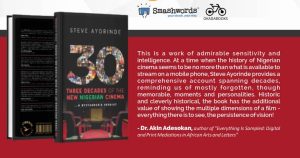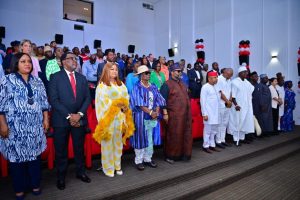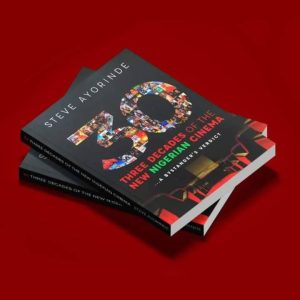Anyone can choose to be an observer. Any observer can choose to document and publish their observations. However, what stands Steve Ayorinde’s recently published documentation of observations out is authority — hence my decision to title this piece “From the Mouth of the Authoritative Bystander.” Authority is earned: in Ayorinde’s case, he has earned the authority to comment on the emergence and growth of the new Nigerian cinema because he is unarguably one of Nigeria’s best and most celebrated film and art critics.
Expertise and experience breed authority, and for Ayorinde, both have been in play in his life. Ayorinde has spent decades as a journalist, media critic, film judge, and international commentator whose takes have often been sought both within and outside the country. Furthermore, he has served Nigeria’s biggest economic state — Lagos State — as a Commissioner for Tourism, Arts, and Culture. All these, among many other achievements and strides, point to Ayorinde’s qualification to embark on the journey to document the evolution and growth of Nigeria’s Nollywood in the past 30 years, a movie and film industry that’s been adjudged as one of the world’s fastest-growing movie industries.

Ayorinde is not new to Nigeria’s movie industry. In his foreword, Prof. Jonathan Haynes takes us back to 1996 — where Ayorinde and Okafor’s media piece introduced and critiqued the nascent Nollywood industry. For Ayorinde, watching this new Nigerian cinema start and grow from his earliest predictions must bring some fulfilment. And while it is still expected to grow in leaps and bounds, writing this book at this point is crucial — as crucial as the newspaper piece of 1996 — for it will serve as a means of taking stock, looking back, gauging achievements, measuring success, and highlighting aspects that need improvement.
In 185 pages, Ayorinde serves his authoritative verdict on the altar of six sub-parts, focusing on feature films, directors, actors, actresses, and landmark events. Through this breakdown, we can quickly examine the evolution through Ayorinde’s parameters.

Ayorinde’s bystander’s verdict opens with a seemingly chronological strip-down of in-depth commentaries on 30 of the most era-defining movies and films produced by the Nollywood industry. These 30 works of art, grouped under the sub-section titled Feature Films, include movies from the days of the early cinema and the VHS cassette player to the days of the VCD to the days of the new cinema and online streaming platforms like Netflix. Ayorinde’s expository commentaries on the films of the first decade of the new Nigerian cinema featured Awada Kerikeri’s Asewo To Re Mecca, NEK Video Films’ Living in Bondage, Mainframe Film and Television Prodcutions’ Ti Oluwa Nile, NEK Video Films’ Glamour Girls, Andy Amenechi’s Mortal Inheritance, Gab Okoye’s Battle of Musanga, Zeb Ejiro’s Domitilla, Cinekraft’s Owo Blow series, Femi Lasode’s Sango, Amaka Igwe’s Forever, Rainmaker 70’s King of My Country, and Andy Amenechi’s Igodo. Through these twelve films, Ayorinde shows us the birth and earliest developmental traits of the Nollywood industry. These films also serve as proof that literature mirrors life and society, as the themes of these movies and many like them that were made in the 1990s reflect the preoccupations of the then Nigerian society — kidnapping, ritualism, prostitution, education as the means to livelihood, the migration to greener pastures in the city, among many other concepts.
Kingsley Ogoro’s Osuofia in London, Jeta Amata’s The Amazing Grace, Niji Akanni’s Aramotu, and Chineze Anyaene’s Ije were Ayorinde’s selected films for the expository commentaries on the new Nigerian cinema’s second decade. Through his commentaries on these feature films, Ayorinde makes us understand that the early 2000s to 2010 marked the era during which Nollywood started to gain global traction and attention. During this period, filmmakers in the industry began to tap into collaborations with foreign producers. Similarly, this period marked an increase in the involvement of female directors and producers in Nigeria’s fast-rising Nollywood industry, as well as the game-changing effects of newer technological equipment to help shoot and project more glossy and flashy films.

Kenneth Gyang’s Blood and Henna, Obi Emelonye’s Last Flight to Abuja, Biyi Bandele’s Half of A Yellow Sun, Kunle Afolayan’s October 1, Ayo Makun’s 30 Days in Atlanta, Izu Okukwu’s ‘76, Steve Guka’s 93 Days, Kemi Adetiba’s Wedding Party and King of Boys, GDN Studios’ Eyimofe, Hassan Giggs’ Sadauki, Funke Akindele’s Omo Ghetto: The Saga, Desmond Ovbiagele’s The Milkmaid, and Izu Ojukwu’s Amina serve as the feature films spotlighted by Ayorinde for the third decade of the new Nigerian cinema. Through these films, Ayorinde showcases the evident changes in the evolutionary trajectory of the Nollywood industry, including massive advertising and influencer marketing made easily through social media platforms and the gross followers industry stars have amassed on social media platforms; collaboration with streaming platforms like Netflix, Amazon Prime, and Showmax, and increasing national and international award nominations.
In reviewing the feature films spotlighted by Ayorinde in the first part of his verdict, one would notice recurrent categories such as comedy, epic, thriller, and drama — enough to posit that these are the most defining and popular film categories that have yet existed in the Nigerian Nollywood space for the past three decades.

In the second part of the book dedicated to directors, Ayorinde profiles 30 of Nigeria’s most iconic film directors — 32 if one chooses to consider two couples separately — a pattern that doesn’t fail to drive home the point that the selection is continued deference to the symbolism of 30, being the number of years for which the new Nigerian cinema has existed. Ayorinde’s profiling ramps up directors from the contemporary to the pioneer directors of the new Nigerian cinema — from Tunde Kelani to Kunle Afolayan, to Okwo Mildred, to Ojukwu Izu, Obi-Rapu Chris, Kenneth Gyang, Kemi Adetiba, Steve Gukas, Obi Emelonye, Ishaya Bako, and Andy Amenechi, among other prolific directors that have worked to place Nigeria’s films on the global map. The profiling includes the directors’ filmography, nominations and awards, the education of these directors and how their education has shaped their work.
In profiling actors, Ayorinde’s selection cuts across several sides of the Nollywood industry (indigenous-language and English films) and different generations of contemporary and pioneer actors. This selection spotlights 30 actors, including Abdullahi Sani Musa, Femi Adebayo, Odunlade Adekola, Gabriel Afolayan, Fred Amata, Ekpeyong Keppy Bassey, Sam Dede, Pete Edochie, Desmond Elliot, Timini Egbuson, Richard Mofe-Damijo, Jideo Kosoko, Olu Jacobs, Osita Iheme, and Chinedu Ikedieze. Like the profiling of directors, this also includes the filmography, industry experience, awards and nominations of each of these actors, and how their work and accolades have shaped the industry and strengthened its relevance.
Trail-blazing Toyin Abraham, Sandra Achums, Taiwo Lycett-Ajai, Funke Akindele, Halima Atete, Hilda Dokubo, Rita Dominic, Adesua Etomi, Kate Henshaw, Nse Ikpe-Etim, Patience Ozokwor, Genevieve Nnaji, Joke Silva, Sola Sobowale, and Mercy Johnson, among other prolific Nigerian actresses, have the spotlight for the third part of the authoritative bystander’s tales. The commentaries on these actresses cut across their filmography, education, work experience, entry into the industry, awards, and influence on the overall Nollywood industry. If not anything, Ayorinde’s careful selection of 30 actresses in a way that diversely and inclusively represents the three decades and the evolutionary milestones of the industry while highlighting the growth and development of these actresses — especially those that have been around since the earliest years — is worthy of applause.

The creative industry burns bright with stars and talents. In the same vein, uneasy lies the heads that wear the crown, and the industry is also the abode of some of the most troubled people. In the fourth chapter of his book, “The Unforgettable Thirty,” Ayorinde pays tribute to some of the best minds and most influential people who have shaped Nigeria’s new cinema — albeit they are no longer alive. Among these “Unforgettable 30” are legendary Hubert Ogunde, Moses Olaiya Adejumo, Adeyemi Afolayan, Sam Loco Efeeimwonkiyeke, Francis Agu, Biyi Bandele, Felicia Mayford. Sadiq Daba, Nura Mustapha Waye, and Chico Ejiro. Given that Africa is a place where we don’t speak ill of the dead and hardly even speak of the dead at all, Ayorinde’s recognition of the “Unforgettable 30” is a bold and commendable act — especially as these actors, actresses, directors, and producers immensely contributed to the birth and growth of the industry.
In “Landmark Events,” the last part of the book, Ayorinde maps out stand-out events that primarily affected the growth of the new Nigerian cinema. These events, which he categorized into three — Decade 1 (1990 – 1999), Decade 2 (2000 – 2009), and Decade 3 (2010 – 2019) include film festivals, conferences, major acquisitions, collaborations in the industry, the exposure of Nollywood to global audiences, the growth and expansion of Nollywood, awards, the birth of the African Magic Viewers’ Choice Awards, and the selection of Nigerians as Academy voters, among other landmark events that have come to prove how far the Nollywood industry has grown and the influence stakeholders in the industry and the industry as an entity has amassed so far.

In the opening paragraph of this piece, I defined authority and the parameters through which I adjudged Ayorinde as an authority on the new Nigerian cinema. If there were to be any doubt about the authoritativeness of this book — and if the sheer amount would not clear those doubts of information shared in the expository profiling of the first four chapters — the “Landmark Events” chapter is a solid proof of how close Ayorinde has been to the source, how closely he has followed and monitored the growth of the industry, and how deeply invested he is in it.
This book is a gift whose value and worth will appreciate as generations pass — it is a goldmine of information that will shape how future generations of researchers, scholars, and critics will view, understand, study, and critique the Nigerian film and movie industry. A product of passion and dedication, the book will remain of considerable value in the decades ahead and will surely become a treasure to behold in our understanding of Nigerian cinemas.









You must be logged in to post a comment.